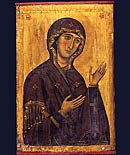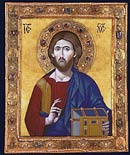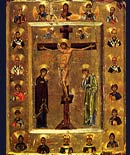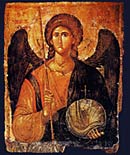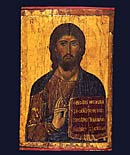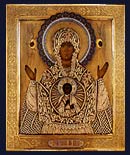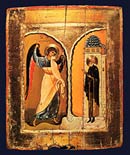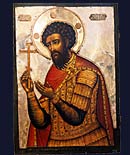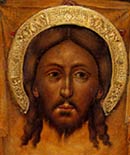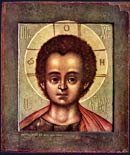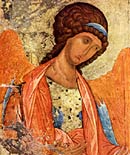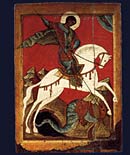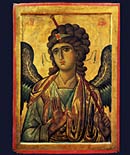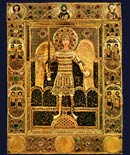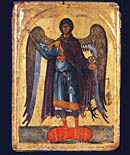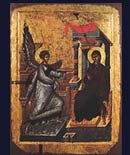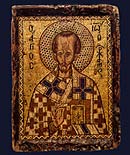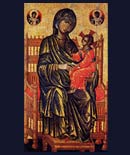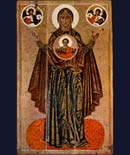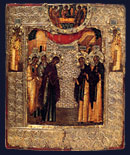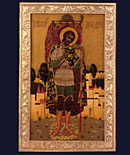Ikon History - Ikons in the Modern Age
It might seem curious to begin a discussion of ikons in the 'modern age' by starting in Russia around 1700, but this period is extremely interesting, as it was a time with Russian ikon painting was colliding head on with Western Art. This was true not only in ikon painting, but also was happening in architecture and the decorative arts. While western styles of art were relatively harmless when it came to palaces and portraits of living men and women, it was quite another thing when it came to ikons of Christ and the saints. The church was very skeptical of innovations from western Europe. The fact that Tsar Peter the Great was a rapid enthusiast for everything from the west meant that the church could not avoid these influences. Production centers of ikons were located in the Kremlin under the Tsar's patronage and it was assured he would give direction in how he the styles his artists used.
Western influences in Russian art were not new. There had been a regular flow of western European popular religious prints and engravings for a very long time. Catholic Poland and Lithuania were very nearby, and their long established cultural connections with Kiev and Ukraine were strong. These influences from abroad had rather a spotty effect on Russian ikon painting. Catholic-appearing ikons were liable to be burnt if found by zealous churchmen.
During the 17th century Russian ikon art had reached an incredible level of technical perfection. The famous Stroganov school was producing jewel-like ikons in luscious colors with incredible detail. Old ikon themes continued to be chosen as subjects, but many Stroganov painters liked to pick new and obscure subjects for their painting. Painters liked to show off their bravura technique with crowed scenes, fantastic architecture and highly decorated clothing on their figures. This style was highly popular among the Muscovite aristocracy, but it did not work very well in monumental church settings. Also, the spiritual aspect of ikon painting suffered in the Stroganov school, when artists were obviously striving for superficial effect, rather than spirituality.
This changes with the arrival of famous artists like Simon Ushakov and Fyodor Zubov (an example of his work is at top left), who worked in the Tsar's Armoury Workshops. The second ikon is by a follower of Ushakov, Filateyev. The ikon is large and was obviously intended for a church ikonstasis. The painting is shows how far western realism was impacting Russian art. Although it carefully follows strict Church canons regarding the depiction of Christ, details, such as the face, show a striving on the part of the artist to create a 'real' person. The modeling of the figure is extremely fine and almost exceeds the ability of egg tempera painting to reproduce soft graduations of shadow. This is a conscious effort of the artist to imitate the effect of oil painting in a media unfriendly to soft shadows. The clothes of Christ, following the Stroganov style, are highlighted in fine lines of gold, which give lend figure a burnished, almost metallic effect.
The second ikon at left, Christ - King of Kings, is very large, about six feet tall. It is a few years earlier than the ikon just discussed and has a number of features that show it comes from the previous decade. Here Christ is shown in regal garb, like a Muscovite Tsar. His clothes are fashioned on the ancient robes of Byzantine Emperors, made of thick orange brocade woven with gold and silver, set with gemstones. In His left hand He carries a wand of authority, while his right gives a traditional Orthodox blessing. Christ's head is adorned with a highly ornate, scaley diadem of superimposed crowns, topped with a cross. The face and hands are delicately modeled.
Next, at left is an unusual ikon of the Theotokos from the 1700's. Here decorative elements completely overwhelm the traditional depiction of the Mother of God with Christ. Behind the figures baroque architecture and unusual motifs compete in a busy background. The Virgin stands behind a table covered with rich brocade and carries a regal scepter which has exploded in bloom. She wears a western-style crown and is dressed in stiff orange-colored gold brocade robes. Two gold vases flank the Virgin and Christ, loaded with tulips and other flowers - perhaps showing the influence of Dutch floral painting. Christ is dressed like a tiny Russian Tsar, crowned and carrying a big orb and is own scepter. In such an ikon all spiritual power inherent in the subject matter seems completely drained. Such an ikon is a more an caprice, rather than an ikon. Its an ornamental painting designed to decorate a fashionable chamber or charm guests.
This type of degenerate ikon art, which attempted to blend western European styles with ikonographical subject matter, while pretty, was a spiritual dead end. However, elite patrons wanted to show-off their increasing sophistication and westernization with ikons that they imagined 'fit in' with artistic currents in the rest of Europe. From 1700 onward the educated and intellectual elites became increasing estranged from Orthodoxy, all the while observing superficial aspects of religious practice. For example, life's milestones, like weddings and births continued to be observed by the gift of ikons. No Russian Orthodox home in St. Petersburg or Moscow would be without its wall or corner of family ikons, rather like long ago, forgotten members of the family, regardless of the convictions of the occupants.
The fourth ikon at left shows the type of ikon that a prosperous family in Russia would have chosen to decorate a dining room or bedroom. It dates from 1908-17, but it could have been produced fifty years earlier. The painting is done in oils and the noteworthy feature isn't Christ, it's the splendid silver-gilt covering which would have dazzled in the special ikon corner of a middle-class home. Such ikons were often mass-produced in factory assembly line settings. Sometimes the figure of the saint underneath was not completed, only the parts that would be exposed were painted.
At the end of the 19th Century Russians were learning to take particular pride in their own culture and heritage. They began to reject aspects of Western culture which seemed overtly foreign. This was particularly true in the decorative and church arts, but the move to old national forms was widespread in all artistic areas, including architecture. From 1860 to the late 1880's this affection for Russian motifs was somewhat hesitant. The old styles still had the aura of the village about them for some sophisticates, and Western forms held on for awhile.
During the reign of the last Tsar there was an explosion of culture in Russia, which has been called the Silver Age. During this time scholars began to study ancient Russian and Byzantine art. Political uncertainties and a general dissatisfaction with the benefits of a western secularized society lead people to look for meaningful spiritual experiences which were rooted in Russia. Ikon painting had always survived in the villages, towns like Palekh and Mistera were traditional centers of ikon art, where generations of families practiced the craft.
The last ikon at left shows St. Gennady of Kostroma. It was painted in Moscow in 1900 and shows a curious, yet successful fusion of a fine linear drawing with an extremely delicate and careful technique. The ikon has a flat, almost brittle feel. The ikon is signed by the artist, which became common after 1700. Celebrated artists of the time, like Vasnetsov and Nesterov tried to integrate traditional ikonography with artistic currents of the time. The results can be seen in the paintings of St. Vladimir's Cathedral in Kiev and in the Art Nouveau influenced religious art of Nesterov at the Martha and Mary Convent in Moscow.
